DDSO blueprint series, Part 5: Incorporating profitable Invisalign therapy into a DDSO-driven model
By Seth Wasson, DMD
Introduction by Brady Frank, DDS
As a participant in the clear aligner space and an innovator in private group practice models, Seth Wasson, DMD, has the ideal background to discuss how clear aligner therapy fits into the DDSO (dentist-owned dental service organization) practice model. Pay attention to how Dr. Wasson has streamlined the clear aligner processes, and you will find yourself enjoying new heights of success.
With the increasing interest in and demand for clear aligner therapy, the playing field is becoming increasingly crowded. Invisalign, however, still remains the face of the product. Since surpassing the five-million case mark, the parent company of Invisalign, Align Technology, continues to innovate.1 As a result, providing Invisalign treatment in a general dental practice can be truly rewarding and profitable. Inclusion of this specialty procedure can greatly impact the cash flow of a practice. Furthermore, using an acceleration technique such as Propel can increase both the predictability and profitability of clear aligner cases.
Introduction by Seth Wasson, DMD
For most Invisalign providers, 14-day wear of aligners is the norm. However, with a clear understanding of the case setup, the expectations of the patient, and knowledge of ClinCheck Pro software (Align Technologies), aligner wear for seven days (or fewer) is possible. Use of an acceleration technique not only increases the frequency of aligner change, but also improves the predictability of the case and therefore decreases the likelihood of refinements. This is an important point to emphasize, as acceleration greatly impacts the bottom line.
From a scheduling and financial standpoint, a typical case looks much like this:
Traditional approach (14-day aligners)
- Records appointment
- Delivery appointment
- Five to six progress appointments
- Removal of attachments and delivery of retainers
- Total doctor time: Approximately 2.5 hours (this assumes no refinement, which is less likely because acceleration is not used)
- $4,850 case fee - $1,829 lab fee = $3,021
- $3,021 / 2.5 hours’ doctor time = $1,280 per hour production
Accelerated approach (five- to seven-day aligners)
- Records appointment
- Delivery appointment with acceleration
- Two to three progress appointments
- Removal of attachments and delivery of retainers
- Total doctor time: 1.5 hours (this assumes no refinement, which is more likely because acceleration is used)
- $4,850 case fee - $1,829 lab fee = $3,021
- $3,021 / (1.5 to 1 hours’ doctor time) = $2,014 to $3,021 per hour
Case overview
A 28-year-old patient presented to address her occlusal dysfunction and increasing crowding of both arches. Invisalign and Propel were recommended to treat her case in a quicker, more predictable fashion. Propel, a series of micro-osseous perforations, was performed to stimulate bone remodeling. Invisalign trays were delivered and changed every five days. A total of 28 aligners were used to treat her case, and Invisalign Vivera retainers were used for her retention phase.
Summary by Brady Frank, DDS
Some of the key principles of growing a DDSO include adding clinical owners to the professional corporation or DDSO entity, acquiring value-added practices, and achieving profit and equity growth for all dentists involved. As more patients seek out practices that provide efficient Invisalign treatment, Dr. Wasson’s approach becomes highly valuable. Whether you’re applying these Invisalign efficiency techniques at your home location or a newly acquired satellite practice, both your patients and business will benefit.
Editor’s note: This is part five of a five-part series on DDSOs. Find previous articles on dentaleconomics.com. Search “DDSO blueprint.”
Reference
1. Align website homepage. https://www.aligntech.com/. Accessed September 16, 2018.
About the Author

Brady Frank, DDS
Brady Frank, DDS, is a third-generation dentist turned entrepreneur, inventor, author, and thought-leader with a passion for teaching others the hard-won lessons he has learned about successfully creating and selling a business. Dr. Frank has expertise on multi-doctor and multi-location private group practices, dental transitions, DSO and DDSO expansion and growth strategies, and healthcare real estate investment, and is most passionate about mentoring others on these topics.

